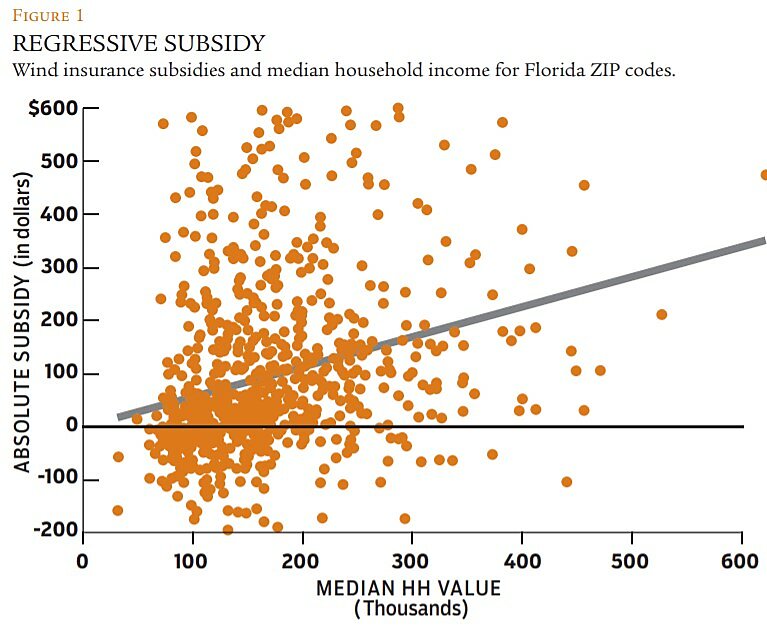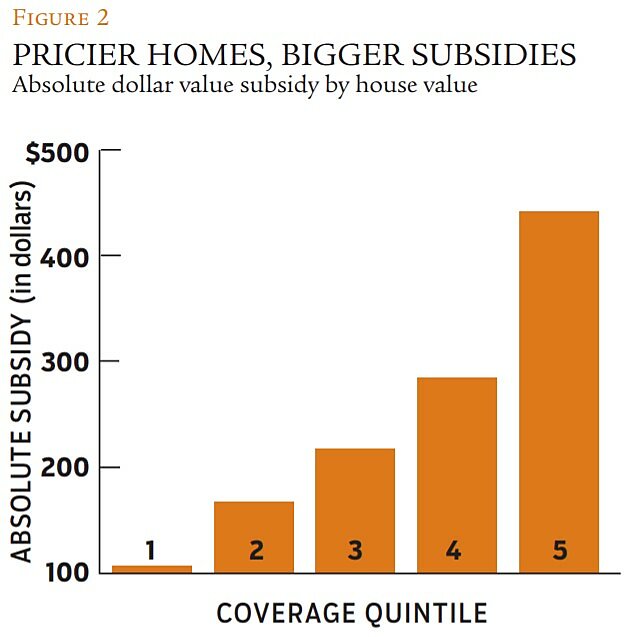Regulating weather risk is an increasingly urgent social issue. Hurricane Katrina in 2005 and Hurricane Sandy in 2012 brought unprecedented property damage to the Gulf and coastal northeastern states. As a result of an enormous development enterprise, the majority of Florida real estate now lies in coastal areas affected by hurricane activity. And the potential rise of sea level and the resulting erosion of the coastline are putting at risk large chunks of prime real estate in numerous regions.
Our thesis is simple: the most effective way to prepare for storms is through disaster insurance. But this preparation would not simply take the form that is commonly thought: insurance as a form of post-disaster relief. Rather, we see insurance as a form of private regulation of safety—a contractual device controlling and incentivizing behavior prior to the occurrence of losses.
Buying insurance is a transaction in which policyholders are prompted to adopt loss mitigation measures. Insurance contracts attach prices to risky behavior and thus force insurance buyers to factor the risk into their decision. Homeowners’ property insurance, by pricing the cost of choosing to live in the path of storms, sends a crucial price signal that could be a key ingredient in driving community development and individual location decisions.
Unfortunately, in the United States, insurance is denied its potential role as an efficient regulator of pre-storm conduct. It does not give people price signals regarding the cost of living in severe weather regions and it does not induce rational community development and infrastructure investment. American insurance fails to achieve those straightforward and enormously important roles for a simple reason: it is provided by the government in a subsidized manner. Insurance premiums are deliberately suppressed—often dramatically so—thus failing to alert private parties who purchase property insurance to the true risk of living dangerously. It allows those private parties to (rationally) assume excessive risk and dump the cost of their coastal living upon taxpayers. We argue that much of the development of storm-stricken coastal areas is due to insurance subsidies and would not be justified otherwise.
This is only the first part of the bad news. There is more, and it gets uglier. Public debates over subsidized weather insurance often ignore the over-development and excessive risk distortion, because they focus on a myth: the myth that insurance must always be affordable. Subsidies are necessary, policymakers have told us repeatedly, because they help support low-income and working-class people who might otherwise be unable to afford insurance and would not be able to remain in their homes. Subsidizing weather insurance is “our moral duty to the poorest people and working people and lower middle income people,” in the words of then-congressman Barney Frank (D–Mass.). The subsidies prevent “working families who are doing everything they can to put food on the table” from losing their homes, according to Sen. M. K. “Heidi” Heitkamp (D–N.D.). The subsidy, in other words, is thought to promote a redistribution that benefits economically weak populations.
We have long suspected that this justification is false. Our suspicion rested on the puzzling differential treatment of hurricanes versus tornados. These two types of severe storms cause similar aggregate magnitudes of property destruction, but federal subsidies apply to flood losses caused by hurricanes, not to wind losses caused by tornadoes. This was puzzling because hurricane victims live closer to water than tornado victims, and it is generally known that living close to water is a privilege of the affluent. This pattern seemed inconsistent with the affordability-of-insurance rationale. We therefore studied the insurance data and we now have evidence that the weather insurance subsidy scheme is indeed a boon to the elite; a redistribution in favor of the wealthy. We present this new evidence here.
Our study, and in particular our findings regarding the myth of affordability, are intended to shed light on recent legislative activity, which unfortunately only made things worse. In the aftermath of Hurricane Sandy and the enormous bill that the U.S. Federal Emergency Management Agency—the agency that administers the federal subsidies for flood insurance—had to foot, Congress with bipartisan support enacted the Biggert–Waters Flood Insurance Reform Act of 2012. It intended to scale back the subsidies and had the potential to provide better incentives for human preparedness for floods.
But Congress did not let this laudable new statute live long enough to do any good. Immediately after it was enacted, subsidy recipients—now scheduled to lose their subsidies—protested. Congress quickly reacted—again, with a rare showing of bipartisan consensus—enacting what amounts to almost a full repeal of the 2012 reform. The Homeowner Flood Insurance Affordability Act of 2014 restored virtually all of the federal subsidies and cross-subsidies for flood insurance. Our results show that the rhetorical premise invoked by supporters of this act—that hard-working low-income people need it to keep their homes—is misguided. The beneficiaries of weather insurance subsidies are not low-income folks.
The Existing Subsidy Scheme
Historically, flood risks were covered through private insurance, if policyholders purchased it as an added coverage, priced separately from the basic homeowners policy. But many property owners opted not to purchase the flood coverage, political and public pressure often led to the federal government providing post-disaster relief, and some floods were simply mind-bogglingly large, producing wide-scale flood-related losses. Those realities led Congress to create the National Flood Insurance Program (NFIP). Through it, the federal government underwrites flood insurance policies at rates that are set by FEMA and subsidized by the Treasury Department. Of course, in the presence of such subsidized options, private companies cannot compete in this niche, and government-provided flood policies dominate the market.
The goal of the NFIP was to condition participation in the subsidized program on communities’ adoption of floodplain management ordinances that reduce future flood risks to new construction. Congress also made the purchase of NFIP policies mandatory for properties that are in certain flood zones and that are subject to federally regulated mortgages. But the rates charged by NFIP to its policyholders violate basic insurance fundamentals. First, they are based on flood maps that are often out of date. Second, property owners in high-risk areas pay well below actuarial rates. And third, political influence, rather than market forces, shapes the process of characterizing particular areas as flood-prone and eligible for subsidies.
The NFIP has been operating at a massive deficit, estimated in 2012 to be around $24 billion. That prompted lawmakers to enact the Biggert–Waters Act, initiating a gradual elimination of the subsidies. The act was designed to phase out the subsidies entirely for certain “repetitive loss properties,” second homes, business properties, homes that have been substantially improved or damaged, and homes sold to new owners. It also permitted a faster pace of rate increases (25 percent annually, up from the previous 10 percent rate hike cap).
However, the backlash from property owners along coastal areas, where resulting premium increases were the greatest, was swift and effective. In some areas, there were reports of homeowners’ premiums rising 10-fold. The concern expressed by many lawmakers, on behalf of their angry constituents, was that unless the new law was repealed, people wouldn’t be able to remain in their homes.
The political pressure was so successful that even Rep. Maxine Waters (D–Calif.), one of the co-authors of the 2012 legislation, voted in favor of repealing it. In 2014, Congress passed the Homeowner Flood Insurance Affordability Act, which largely restored the old subsidy scheme. For example, the new law also called on FEMA to keep premiums at no more than 1 percent of the value of the coverage, which in many flood territories is dramatically below true risk.
Wind insurance / Another category of large-scale, government-sold insurance for weather risk includes state-owned insurance corporations that specialize in wind-damage coverage. Most prominent among them is Florida’s Citizens Property Insurance Corporation, which provides the vast majority of the wind insurance for properties on the coast of Florida.
Like a private insurance company, Citizens prices its policies based on risk. It divides the state into 150 geographic rating territories and sets its rates based on weather patterns, construction methods, and past losses in each territory. But there is one big difference compared to private insurance. Like the premiums charged for flood coverage at the federal level by NFIP, the premiums Citizens collects from Florida policyholders are far below what is necessary to cover the full risk, and are politically mandated to be so (as state regulations limit Citizens’ ability to raise rates). Citizens does not face the same loss constraints that private insurers do; if the premiums are not enough to pay for the wind damage, Citizens can cover the shortfall by passing it on to Florida’s taxpayers.
Affordability?
The subsidies embodied in government insurance are an intended feature because they are thought to favor economically weak homeowners; they are definitely not thought to be a bailout for the rich. “This is not about the millionaires in mansions on the beach…. These are middle-class, working people living in normal, middle-class houses doing their best to raise their kids, contribute to their communities, and make a living,” explained then-senator Mary Landrieu (D–La.). This perception explains why even people not affected by weather insurance subsidies (but who, perhaps unbeknownst to them, pay taxes to fund them) strongly support the subsidies. In one survey, only 15 percent of unaffected Florida citizens supported the premium increases.
The cross-subsidy created by government-sold insurance follows, then, a distinct logic: it moves from people lucky enough to live in safe areas (“the affluent”) to the less lucky residents living in low-lying areas in storms’ paths (“the poor”). But this conjecture, that subsidized flood insurance benefits the less affluent, had not been tested. We long believed that it is wrong and that the opposite is true: the subsidy accrues primarily to the affluent. This, for a simple reason: those who need flood insurance most are the habitants of properties build in proximity to the coast, where severe weather strikes most forcefully. You don’t need to be a real estate economist to know that people pay a premium to live close to the water. Are we really asking middle-class taxpayers to subsidize beachfront property owners, all in the guise of “affordability”?
To test this hypothesis, we examined Florida’s wind-peril insurance policies, which are sold and subsidized by the state-owned Citizens. Those data include information about each individual policy and the actual premium charged. Also, by state law, the data have to include an exact estimate of the subsidy enjoyed by each policyholder—namely, how much more Citizens would need to charge this policyholder to bring the premium to its hypothetical true risk level, which would not require a subsidy from the state.


